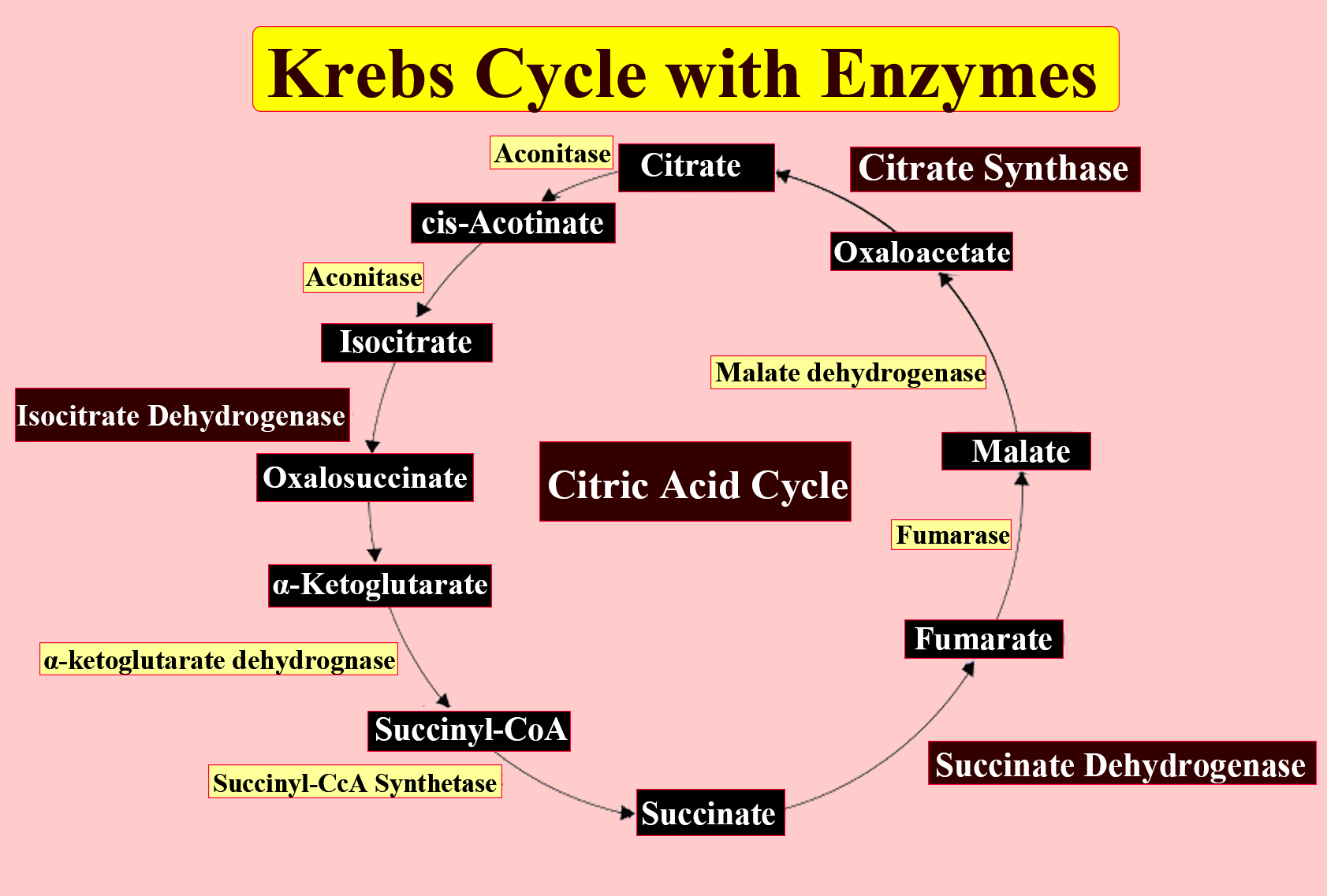
An enzyme not used in Krebs’s cycle is:
(a) Aconitase
(b) Decarboxylase
(c) Fumarase
(d) Aldolase
Answer
564.3k+ views
Hint: Krebs’s cycle or citric acid is a cyclic process of 8 enzyme reactions which occur in mitochondria. It converts acetyl CoA to carbon dioxide accompanied by the release of energy. It occurs in the mitochondrial matrix.
Complete step by step answer:
2 molecules of pyruvate are obtained from glycolysis which occurs in the cytosol. Now, this pyruvic acid molecule is acted upon by the enzyme pyruvate dehydrogenase. The enzyme catalyzes the addition of coenzyme-A by oxidative decarboxylation. One molecule of NADH is reduced in this reaction. In the next reaction, acetyl CoA which is a 5C containing compound is converted to citrate (6C) by the action of enzyme citrate synthase. Citrate is then converted to Iso-citrate under the action of enzyme aconitase. Over the course of the next 2 reactions, succinate (4C) is obtained. Succinate is then converted to fumarate by a dehydrogenation reaction catalyzed by enzyme fumarase.

This can be better understood from the diagram given below:
On the other hand, aldolase is an enzyme from the glycolytic pathway. It cleaves one molecule of fructose 1,6 bisphosphate into one molecule of 3 phosphoglyceraldehyde and one of dihydroxyacetone phosphate. So, aldolase is not an enzyme for Krebs’s cycle.
So, the correct answer is ‘Aldolase’.
Note: Glycolysis and Krebs’s cycle are linked processes that together complete cellular respiration. The end product of glycolysis is 2 molecules of pyruvate. The cycle mentioned above is always operating in two turns i.e. one cycle per pyruvate molecule. After completion of glycolysis, Krebs cycle, and electron transport chain, each glucose molecule yields 38ATP molecules.
Complete step by step answer:
2 molecules of pyruvate are obtained from glycolysis which occurs in the cytosol. Now, this pyruvic acid molecule is acted upon by the enzyme pyruvate dehydrogenase. The enzyme catalyzes the addition of coenzyme-A by oxidative decarboxylation. One molecule of NADH is reduced in this reaction. In the next reaction, acetyl CoA which is a 5C containing compound is converted to citrate (6C) by the action of enzyme citrate synthase. Citrate is then converted to Iso-citrate under the action of enzyme aconitase. Over the course of the next 2 reactions, succinate (4C) is obtained. Succinate is then converted to fumarate by a dehydrogenation reaction catalyzed by enzyme fumarase.

This can be better understood from the diagram given below:
On the other hand, aldolase is an enzyme from the glycolytic pathway. It cleaves one molecule of fructose 1,6 bisphosphate into one molecule of 3 phosphoglyceraldehyde and one of dihydroxyacetone phosphate. So, aldolase is not an enzyme for Krebs’s cycle.
So, the correct answer is ‘Aldolase’.
Note: Glycolysis and Krebs’s cycle are linked processes that together complete cellular respiration. The end product of glycolysis is 2 molecules of pyruvate. The cycle mentioned above is always operating in two turns i.e. one cycle per pyruvate molecule. After completion of glycolysis, Krebs cycle, and electron transport chain, each glucose molecule yields 38ATP molecules.
Recently Updated Pages
Why are manures considered better than fertilizers class 11 biology CBSE

Find the coordinates of the midpoint of the line segment class 11 maths CBSE

Distinguish between static friction limiting friction class 11 physics CBSE

The Chairman of the constituent Assembly was A Jawaharlal class 11 social science CBSE

The first National Commission on Labour NCL submitted class 11 social science CBSE

Number of all subshell of n + l 7 is A 4 B 5 C 6 D class 11 chemistry CBSE

Trending doubts
Differentiate between an exothermic and an endothermic class 11 chemistry CBSE

10 examples of friction in our daily life

One Metric ton is equal to kg A 10000 B 1000 C 100 class 11 physics CBSE

Difference Between Prokaryotic Cells and Eukaryotic Cells

1 Quintal is equal to a 110 kg b 10 kg c 100kg d 1000 class 11 physics CBSE

State the laws of reflection of light




